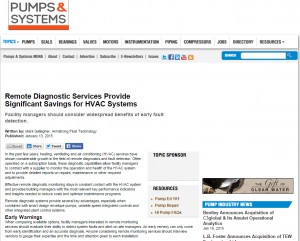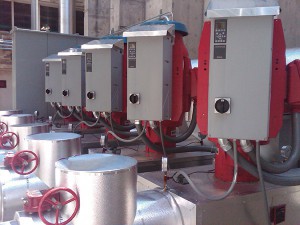As seen on pumpsandsystems.com - January 13, 2015
 In the past few years, heating, ventilating and air conditioning (HVAC) services have shown considerable growth in the field of remote diagnostics and fault detection. Often operated on a subscription basis, these diagnostic capabilities allow facility managers to contract with a supplier to monitor the operation and health of the HVAC system and to provide detailed reports on repairs, maintenance or other required adjustments.
In the past few years, heating, ventilating and air conditioning (HVAC) services have shown considerable growth in the field of remote diagnostics and fault detection. Often operated on a subscription basis, these diagnostic capabilities allow facility managers to contract with a supplier to monitor the operation and health of the HVAC system and to provide detailed reports on repairs, maintenance or other required adjustments.
Effective remote diagnostic monitoring stays in constant contact with the HVAC system and provides building managers with the most relevant key performance indicators and insights needed to reduce costs and optimize maintenance programs.
Remote diagnostic systems provide several key advantages, especially when combined with smart design envelope pumps, variable speed integrated controls and other integrated plant control systems.
Early Warnings
When comparing available options, facility managers interested in remote monitoring services should evaluate their ability to detect system faults and alert on-site managers. An early remedy can only come from early identification and an accurate diagnosis. Anyone considering remote monitoring services should interview vendors to gauge their expertise and the time and attention given to each installation.
 When combined with smart design envelope pumps, variable speed integrated controls and other integrated plant control systems, an effective remote diagnostic service in constant contact with a buildings HVAC system can significantly reduce energy costs. (Images courtesy of Armstrong Fluid Technology)
When combined with smart design envelope pumps, variable speed integrated controls and other integrated plant control systems, an effective remote diagnostic service in constant contact with a buildings HVAC system can significantly reduce energy costs. (Images courtesy of Armstrong Fluid Technology)
Gathering Data
Managers will also benefit from understanding the nature and structure of the data gathering and analysis service. A diagnostic and analytic service must provide exhaustive data collection, embedded interpretation and rule-based conclusions.
Although some suppliers offer detailed insight through building management systems (BMS) and can gather data points from each input/output module, they may not gather data from any of the components beyond the reach of the BMS. Managers must carefully examine the scope of the service—how many data points it gathers and how often, as well as its system for assembling detailed analyses of HVAC operations and system efficiencies.
Diagnosis
Managers should also understand the degree to which they are expected to perform their own diagnoses. In some instances, vendors offer remote monitoring only.
Other available services provide varying degrees of oversight, analysis and immediate push notification of important status changes. Additional services typically come at an additional cost, but for managers interested in maximizing value and protecting the health of their HVAC system, the added services are an important consideration.
Expert Analysis
Another important factor to consider when evaluating remote monitoring systems is the training and industry experience of the individuals reviewing and analyzing data. Many remote monitoring service providers delegate the task of analysis to untrained or junior technical staff. Individuals in these roles can detect obvious changes in data trends and might reach some reasonable conclusions, but only a seasoned expert accustomed to reviewing and analyzing data from HVAC installations will be able to spot the subtle changes that represent fading efficiency in major components. Similarly, only an experienced HVAC expert can reliably and accurately synthesize multiple data points to determined required actions.
Astute managers will interview vendors carefully to determine the qualifications and experience of those who monitor, review and analyze performance data.
Complete System
When comparing monitoring services, purchasing managers must understand the breadth of service offered. Specifically, how many components are included in the monitoring service? How many points of data will be collected, at what frequency and from how many sources within the system?
To get a complete view of an HVAC system’s operation—including pumps, chillers, fans, valves, controls, user access, adjustments, vibration, energy efficiency and energy usage—component monitoring systems must consider every data point important and gather data from as many points as possible.
Many monitoring services record data from only the items under the purview of the BMS system and do not monitor pumps, valve status, fan operation, approach temperatures or component vibration.
Each component can provide valuable streams of data for HVAC experts who want to understand the inner workings of their complex systems.
Mark Gallagher is global manager, Building Services, at Armstrong Fluid Technology. In this capacity, he oversees the introduction and delivery of fee-based services to Armstrong’s global customer base, including the ECO*Pulse HVAC Health Management service.
Two Facilities Reap Major Benefits from Remote Monitoring
Two recent installation studies demonstrate the benefits of outside monitoring, detailed data gathering and expert analysis combined with recommendations for adjustments, maintenance and repairs.
Hospital Revitalization
 An IPCS featuring several intelligent pumps helped a Texas hospital save more than $300,000 per year in energy costs.
An IPCS featuring several intelligent pumps helped a Texas hospital save more than $300,000 per year in energy costs.
In 2011, a major Texas hospital overhauled its HVAC system equipment. Prior to the upgrade, the hospital had been spending more than $78,000 each month on cooling alone. The retrofit project involved replacement of cooling towers, piping, HVAC pumps and system controls.
The hospital worked with a local contractor who had a relationship with a major fluid technology solutions provider. The contractor worked closely with the manufacturer to select an advanced integrated plant control system (IPCS) and an innovative new diagnostic system for ongoing monitoring, analysis and advice. In early January 2013, the remote HVAC monitoring and diagnostic program was installed. In the months that followed, the manufacturer collaborated with the hospital and its service contractor to analyze quarterly performance data and make appropriate recommendations for adjustments according to the subscription agreement.
The analysis revealed that the building operator had made unnecessary changes to the setpoint that would have cost the hospital $80,000 if left unchecked for an entire year. Based on this analysis, the hospital incorporated critical system changes and saved more than $27,000 per month compared with the originally installed equipment.
Veterans Affairs Facility
Two separate but nearly identical Veterans Affairs medical facilities in California also show the benefits of remote diagnostics and fault detection in HVAC systems. The two medical buildings, designed and built in the mid-1990s, feature the same building design, size, mechanical configuration, chiller model, pumps, cooling tower, control equipment and sequencing equipment. Both are in Southern California, so the two buildings are exposed to nearly identical weather patterns and have similar cooling requirements.
The difference between these two facilities is that only one of them uses a remote monitoring service. During the 18 months following the installation, the building that relies on remote monitoring and diagnostics from an outside expert used 50 percent less energy for cooling than the building without the service.
Careful diagnostics identified a variety of issues, including a low refrigerant in one chiller, a partially blocked cooling tower, an isolation valve left in manual and an incorrectly wired component. Without remote monitoring, many of these problems would have remained undetected.
And, improper wiring notwithstanding, the identical HVAC system, now properly installed and adjusted, performs 50 percent better than the identical system in another building under nearly identical load conditions.





